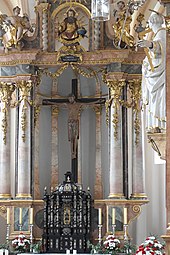Holy Cross (Forstenried)
Heilig Kreuz is a Roman Catholic parish church in the Forstenried district of Munich . Part of the altar is a Romanesque crucifix ; it was ascribed a miracle effect, it made Forstenried a place of pilgrimage and was the reason for the building of the church.
Location and building
The parish church Heilig Kreuz is located in the old village center of today's Munich district Forstenried . The church is surrounded by a cemetery.
The late Gothic building dates from the first half of the 15th century; it was redesigned in the baroque style by Kaspar Zuccalli in 1672 . The tower was raised in the first third of the 17th century and equipped with an onion dome. The rococo interior of the church was created in 1749.
The nave of the church in the west has a saddle roof , the retracted choir a hipped roof . The walls are supported by buttresses on the outside. The tower is built into the nave, on a square floor plan in the lower part and an octagonal one in the upper part.
The richly stuccoed barrel vault inside the church, tapering to a point at the ends, is a baroque reconstruction of the original ribbed vault .
Furnishing
The most important work of art is a Romanesque crucifix from Andechs Monastery ; it is dated around 1170 and is painted in the Byzantine manner. Both feet of the Savior are fastened with the same nail; With this type of representation, the Forstenrieder Cross is one of the first in the German-speaking area. The rest of the furnishings come mainly from the Baroque and Rococo periods. The Romanesque cross is integrated into the high altar from 1611; It is flanked by figures of Saints Helena and Bartholomew . The wooden tabernacle dates from 1700; it is made of dark wood and richly decorated with silver. The right of the two side altars from 1620 bears a painting of the Assumption of Mary, a work by Johann Matthias Kager ; the lamentation of Christ is depicted on the left. Figures of Christ, Mary, and the apostles on the walls are dated to 1620 or 1672. The pulpit dates from 1746. Wenzeslaus Albert created the pictures of the Stations of the Cross in 1769.
organ
The organ built Anton Bayr originally with 9 registers on a manual and pedal with Sharper and mechanical play and register contracture . Only the early Classicist prospectus (1790?) Is preserved , which is designed in five parts with a raised central tower and lateral harp fields. The two-part Rückpositiv is attached to the side of the gallery parapet. Today's two-manual work comes from Georg Jann from 1978. It has 17 registers and the following disposition :
|
|
|
||||||||||||||||||||||||||||||||||||||||||||
- Coupling : II / I, I / P, II / P
history
The predecessor of today's church was a chapel consecrated to St. Bartholomew, belonging to Polling Monastery , with parish rights from 1194. It is assumed that the Romanesque cross has been in Forstenried since the end of the 14th century, according to legend since 1229. Since the cross was ascribed miraculous activity, Forstenried became a regular destination for pilgrimages, which in turn was the reason for building the church and choosing the Patronage of the Holy Cross . Another influx of pilgrims was the reason for the baroque redesign. With the secularization of 1803, membership of the Polling Monastery ended; the north entrance, characteristic of pilgrimage churches, was replaced by an entrance on the south side of the church. As evidence of the role of Heilig Kreuz as a pilgrimage church, there are still wayside crosses on the outskirts of Forstenried.
In 1949 the temporarily redesigned cross was returned to its original Romanesque shape, the altar was simplified and the two figures were placed on the side of the cross. From 1985 to 1986 the interior was repaired and modifications to the Rococo furnishings were reversed.
Pastor
Father Klaus Desch ( ISch ) and as parish administrator Father Stephen Arockiam (ISch).
literature
- Denis A. Chevalley, Timm Weski (ed.): Monuments in Bavaria. State capital Munich - Southwest . Lipp, Munich 2004, ISBN 3-87490-584-5
- Michael Hartig, Alfred Glowka: Parish and pilgrimage church Forstenried - Munich (= small art guides / churches and monasteries ). Schnell and Steiner, Regensburg 1970.
Web links
- Internet presence of the Heilig Kreuz Forstenried community - including pictures of the interior of the church
- Organ database
Individual evidence
- ^ Organ Database (Dutch), accessed September 4, 2019.
Coordinates: 48 ° 5 ′ 6.7 ″ N , 11 ° 29 ′ 39.2 ″ E

